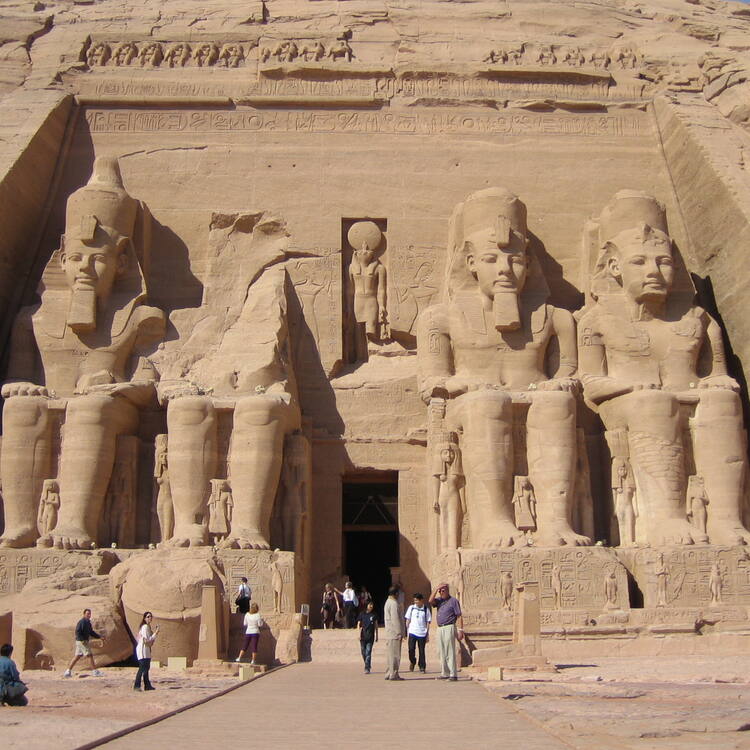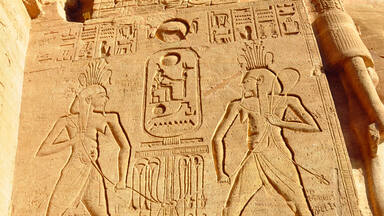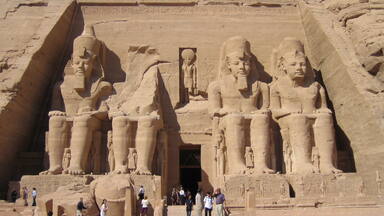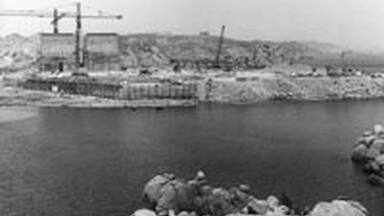Nubian Monuments from Abu Simbel to Philae
Nubian Monuments from Abu Simbel to Philae
This outstanding archaeological area contains such magnificent monuments as the Temples of Ramses II at Abu Simbel and the Sanctuary of Isis at Philae, which were saved from the rising waters of the Nile thanks to the International Campaign launched by UNESCO, in 1960 to 1980.
Description is available under license CC-BY-SA IGO 3.0
Monuments de Nubie d'Abou Simbel à Philae
Cette zone archéologique est jalonnée de monuments admirables, comme les temples de Ramsès II à Abou Simbel et le sanctuaire d'Isis à Philae, qui purent être sauvés lors de la construction du haut barrage d'Assouan grâce à une campagne internationale lancée par l'UNESCO en 1960 qui se poursuivit jusqu'en 1980.
Description is available under license CC-BY-SA IGO 3.0
معالم النوبة من أبو سمبل إلى فيلة
في هذه المنطقة الأثريّة مبانٍ مثيرة للعجب مثل معبد رمسيس الثاني في أبو سمبل ودار عبادة إيزيس في جزيرة فيلة اللذين أمكن انقاذهما لدى بناء سدّ أسوان بفضل حملةٍ دوليّةٍ أطلقتها اليونسكو عام 1960 واستمرت حتّى العام 1980.
source: UNESCO/CPE
Description is available under license CC-BY-SA IGO 3.0
阿布辛拜勒至菲莱的努比亚遗址
这一重要区域有大量极具考古价值的宏伟古迹,包括阿布辛拜勒(Abu Simbel)的拉美西斯二世神庙(Temples of Ramses II)和菲莱(Philae)的伊希斯女神圣殿(Sanctuary of Isis)。这些古迹在1960至1980年间曾险遭尼罗河涨水毁坏,多亏联合国教科文组织发起的国际运动,最终才幸免于难。
source: UNESCO/CPE
Description is available under license CC-BY-SA IGO 3.0
Памятники Нубии от Абу-Симбел до Филэ
Эта исключительно интересная с точки зрения археологии территория включает такие великолепные памятники как храм Рамзеса II в Абу-Симбел и святилище Изиды на острове Филэ. Они были спасены от затопления поднимающимися водами Нила благодаря международной кампании, инициированной ЮНЕСКО в 1960-1980 гг.
source: UNESCO/CPE
Description is available under license CC-BY-SA IGO 3.0
Monumentos de Nubia, desde Abu Simbel hasta Philae
Nubia es una zona arqueológica excepcional, jalonada por monumentos admirables como los templos de Ramsés II en Abu Simbel y el santuario de Isis en Philae, que fueron salvados de la crecida del Nilo provocada por la construcción de la presa de Asuán, gracias a una campaña internacional auspiciada por la UNESCO que comenzó en 1960 y finalizó en 1980.
source: UNESCO/CPE
Description is available under license CC-BY-SA IGO 3.0
アブ・シンベルからフィラエまでのヌビア遺跡群
1959年からのアスワン・ハイダム建設により、フィラエ島イシス神殿など、エジプト南部からスーダン北部にかけてのナイル川流域の地、ヌビア遺跡群が水没の危機にさらされた。このため1960年ユネスコが国際協力を呼びかけ、その結果アブ・シンベル神殿とフィラエ島の遺跡など20件以上の移築工事が行われた。source: NFUAJ
Nubische monumenten van Abu Simbel tot Philae
Het openluchtmuseum van Nubië toont elementen die nauw verbonden zijn met een lange Egyptische faraogeschiedenis. Het gebied bevat prachtige monumenten, zoals de tempels van Ramses II in Abu Simbel en het Heiligdom van Isis in Philae. Ramses II bouwde de tempel Abu Simbel voor zichzelf in het oude Nubië, dat toen bij Egypte hoorde. De Grote tempel heeft vier kolossale beelden uit rots gehouwen en bevestigd aan de rotswand. De beelden stellen Ramses II voor, zittend met de dubbele kroon van Neder en Opper-Egypte. Tussen en naast de benen van de farao’s zijn – veel kleiner en rechtopstaand – prinsen, prinsessen en koningin Nefertari afgebeeld.
Source: unesco.nl
Outstanding Universal Value
Brief synthesis
The Nubian Monuments from Abu Simbel to Philae lie in the Governorate of Aswan. It is a serial property of ten component parts covering 374.48 ha: Abu Simbel, Amada, Wadi Sebua, Kalabsha, Philae (Island of Agilkia), Old and Middle Kingdom Tombs, Ruins of town of Elephantine, Stone quarries and obelisk, Monastery of St. Simeon, and the Islamic Cemetery. The first five component parts contain temples moved during the UNESCO International Campaign from 1960 to 1980 to save them from flooding by the Nile and Lake Nasser because they were recognised as internationally significant by the international community. The remaining five cover antiquities of the Aswan area.
This stretch of the Nile from Aswan in the north to the Sudanese border in the south is an archaeological haven. Home to temples ranging from the New Kingdom to the Ptolemaic and Roman periods, as well as early Coptic sites and villages, the region’s monuments represent the breadth of Nubian cultural articulations, and the various influences shaping the culture over time.
Aswan, north of the first cataract, was the border town of ancient Egypt, an essential strategic point in ancient Egypt, and base for Egyptian activities to the south, whether trade or military raids. From prehistoric times onwards, expeditions were mounted to dominate Nubia. In each of the great periods of Egyptian history, there was, if only partially, a seizure of Nubia, which became a natural annex to the Kingdom and later a colony whose fiscal and commercial income was transferred to Aswan.
The monuments of the property include exceptional architecture, such as the Great Temple at Abu Simbel, carved out of an escarpment of solid rock. Its design and layout allow rays of the sun to penetrate to the innermost chamber twice annually on the equinoxes. Philae above the first cataract was the great Ptolemaic sanctuary of the goddess Isis - renowned since Greco-Roman antiquity for its temples and their annexes. The final bastion of ancient Egyptian religion, the rites of the cult of Isis persisted there until the 9th century CE.
Other than Abu Simbel and Philae, the property includes the temples of Amada, constructed by Tuthmosis III and by Amenophis II, of Derr (also at Amada), those of Wadi Sebua, Dakka and Maharraqa (at Wadi Sebua), the temple of Talmis (removed to Kalabsha), the kiosk of Kartassi, and the temple of Beit el Wali.
At Aswan, numerous monuments testify to the importance of this commercial, military and practical centre. Officials in charge of Nubian affairs in the Old and Middle Kingdoms constructed richly decorated tombs in the Qubbet el Hawa Mountain, while the town of Elephantine yields an overwhelming quantity of interesting finds. The stone quarries, with an unfinished obelisk left behind, are the basis of knowledge of ancient Egyptian quarrying technology. The well preserved ruins of the monastery of St Simeon on the west bank are one of the biggest monasteries in Egypt.
The region of the first cataract is distinguished by its complex theology, promulgated by the priesthoods of the region competing for the attention of their Ptolemaic rulers in Alexandria. Despite, or perhaps due to this complexity, ancient belief lasted long in the region. The myth of Osiris is represented with a high degree of symbolism throughout the region, the most refined depiction of which lies within Hadrian’s gate on the west side of the island of Philae. The scenes depicted at Philae survive in contemporary cultural manifestations in the Egyptian feast of “Sham al-Neseem”.
Criterion (i): Several of the monuments included in property are unanimously recognised as masterpieces of the human creative spirit, such as the temples of Abu Simbel, carved out of the rocks by order of Ramses II; and, above the first cataract, the great sanctuary of the Goddess Isis at Philae, built in the Ptolemaic period and renowned since Greco-Roman antiquity for its temples and their annexes, where the last Pharaohs and Roman emperors (up to Hadrian) have left their names, the jewel of which is the very elegant and very famous Trajan’s kiosk.
Criterion (iii): Other than Abu Simbel and Philae, the property embraces the temples of Amada, constructed by Tuthmosis III and Amenophis II, of Derr (also at Amada), those of Wadi Sebua, Dakka and Maharraqa (at Wadi Sebua), the temple of Talmis (removed to Kalabsha), the kiosk of Kartassi, the temple of Beit el Wali. This unique series of prestigious monuments, dating from the 15th century BCE to the second century CE, are, at once, both rare and ancient. To these must be added the astonishing granite quarries of Aswan, exploited by the pharaohs from early antiquity, with unfinished monuments, colossi and obelisks.
Criterion (vi): The Nubian Monuments from Abu Simbel to Philae bring together cultural properties closely associated with the unfolding of a long sequence of Ancient Egyptian history.
Integrity
The property contains all attributes necessary to express its Outstanding Universal Value within the boundaries of its component parts. Through the praiseworthy and meticulously considered efforts to save the monuments moved during the UNESCO campaign, not only was the physical fabric preserved, but also their integrity, thus preserving a high degree of intactness. The property is affected by wind, temperature change, rains, humidity, bird droppings, dust, and the impacts of tourism, visitation, and the development projects. However, totally the visual integrity of the property's components is still intact. The most major challenge facing the property's component parts is the conservation, forward planning, and visitor management. Capacity development for each of these needs to be brought together in one Management Plan that sets out an overall governance structure.
Authenticity
While the temples moved during the UNESCO campaign are no longer in their original position and have been disassembled and reconstructed, the care and skill with which these projects were carried out means that the form and design as well as the spirit of these places continues to be authentic. The remains around Aswan are archaeological sites which retain the authenticity of their materials and substance and in many cases form and design also.
Protection and management requirements
The extent of the property is very large with its ten component parts spread over-hundreds of kilometres. Its protection is ensured by a comprehensive system of statutory control operates under the provisions of the Protection of Antiquities Law No. 117 of 1983 as amended by the Law No. 3 of 2010, and No. 91 of 2018 and the law No. 20 of 2020, for the protection of monuments, which also established the rules for preserving archaeological sites, Environmental Law No. 4 of 1994, Urban harmony Law No. 114 of 2006 and Building Law No. 119 of 2008.
The property is owned by the State, Region and private owners. Its various elements are managed and protected by the Supreme Council of Antiquities through the Antiquities inspectorate of Aswan in coordination with Aswan Governorate and other relevant authorities as a functional and effective management system. First to be addressed was the granite quarries of the Cataract area with its unfinished obelisk, then the management of Elephantine Island with the assistance of the Swiss Institute, both with Management Plans now complete and in effect. The most recent efforts have centred on the Temple of Kom Ombo and its Crocodile Museum, the restoration and completion of which will soon be inaugurated.
Currently, final Management Plans are in developmental stages for the saved temples of Southern Nubia (i.e. Philae, Wadi Sebua, and Qasr Ibreem). Despite the efforts for protection and the requirement to retain its World Heritage status, currently, a comprehensive management plan for the overall property is in developmental stage.
Regarding the buffer zone as part of Protection and Management, according to the Antiquities Law No. 117 in Egypt, ‘‘an area surrounding the archaeological sites is determined by a decision of the Minister of Tourism and Antiquities based on the proposal of the Board of Directors of the Supreme Council of Antiquities and after the approval of the competent permanent committee, in order to achieve full protection for these archaeological sites, in addition to defining an approved beautification line for the archaeological sites, this area that surrounds the area adjacent to the antiquity, and extends for a distance. A decision shall be issued by the Minister of Tourism and Antiquities based on the proposal of the Board of Directors and after the approval of the competent permanent committee, in a manner that ensures that the aesthetic aspect of the antiquity is not distorted”. This is currently applied on the ten archaeological sites of the Nubian Monuments World Heritage site. Besides that, the archaeological sites have special natural protection for a lot of them, as Abu Simbel, Amada, Wadi Sebua, Kalabsha Stone and quarries, which are located in the desert, in addition to other sites located on islands such as Philae (Island of Agilkia), ruins of town of Elephantine, where there are not any human activities surrounding them. Therefore, the definitions of the surrounding areas in the Antiquities Law in Egypt play the same function of the buffer zone in the Operational Guidelines.

 View photos from OUR PLACE the World Heritage collection
View photos from OUR PLACE the World Heritage collection


